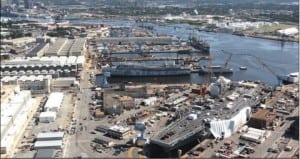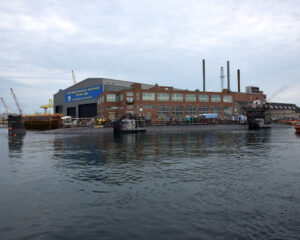The Navy is planning to begin a “scoping study” within a year to determine if the service needs to set up a fifth public shipyard to help maintain submarines in the future, an official said this week.
During the annual Naval Submarine League symposium, Rear Adm. Jonathan Rucker, program executive officer for attack submarines (PEO SSN), told reporters the Navy is often asked about the possibility of the service executing a fifth public shipyard.

“The question in our current capability, within our public yards, we are not achieving what we want. We’re studying that, figuring out how to get more efficient. And then the question is always, well, when you’re done with that, do you think you need [a fifth public shipyard]? The answer is we don’t know. So the answer is, maybe but right now, I wouldn’t go out and tell anybody that we absolutely need one,” Rucker said last week.
He said it will probably take up to two years until the scoping study is complete.
The Norfolk Naval Shipyard (NNSY), Portsmouth Naval Shipyard (PNSY), Puget Sound Naval Shipyard and Intermediate Maintenance Facility (PSNS&IMF), and Pearl Harbor Naval Shipyard and Intermediate Maintenance Facility (PHNSY&IMF) execute maintenance on nuclear-powered submarines and aircraft carriers.
Rucker said the Navy has been asked to “scope what we’d need to go look. So right now we’re in a stage to say, ‘Let’s go scope how capable our shipyards could be.’”
The service will look at “how efficient will we be” when it finishes the Shipyard Infrastructure Optimization Program (SIOP) to improve and modernize the current four government-owned public shipyards, he said.
The Navy established SIOP in 2018, with a goal of spending upwards of $21 billion over 20 years to modernize the four yards. In May, a Government Accountability Office report said the cost of renovating the dry docks, a major part of SIOP, has grown by over 400 percent (Defense Daily, May 17).
The scoping study will seek to examine how efficient the four public shipyards will be along with private capabilities, suppliers and outsourcing work once SIOP is complete.
“Where does that put us in capability and capacity? And at that point, then you could decide, do we need to go look at something [like a fifth shipyard],” Rucker said.
He noted this means the Navy will first try to determine their true capability and capacity in nuclear-powered ship maintenance and modernization, before figuring out the best solutions to get to the proper level.
“Because if we make the assumption that we’re never going to get better, the answer’s then we don’t have enough, but we’re doing a lot of stuff” now to improve, Rucker said.

He admitted what the Navy is currently doing to improve submarine maintenance “are things that I would say, probably were staring us in our face, and we didn’t really get after them. We also underestimate.”
Rucker said the Navy underestimated the impact of the COVID-19 pandemic on the workforce and the ability of the government to hire and train enough new maintenance workers at a suitable pace.
“So those are the things we can tackle today. A decision to go add another shipyard, if that was ever made, is a pretty big path to go down.”